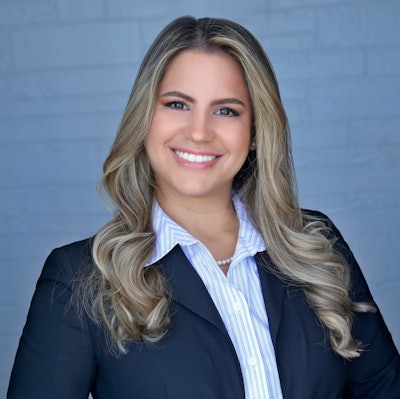
Production-by-provider reports will give you a snapshot of what each clinician produces in gross dollars for the practice. Further, the breakdown of codes will show production by code for each provider.
Your practice's ‘bread and butter’ is crown and prosthetics
 Estela Vargas.
Estela Vargas.
In many general and small group practices, the "bread and butter" code is restorative, particularly with crown and bridge services. Manage your cash flow by tracking these numbers monthly and monitor collections of these restorations, because they are crucial to practice growth and survival.
Patients who pay with cash or patients who are on a discount dental plan (that your practice accepts) pay for crown and bridge services at the date of preparation and any balance at the date of the seat.
Insurance plan payments may be delayed if the claims are not submitted correctly, but your lab bills, payroll, supplies, and more must be paid in the meantime. Insurance plans may take up to 45 to 60 days if denials or requests for more information hold up payment of the claim.
Preventing denied or delayed claims is key to cash flow and revenue recovery
If you have a high insurance accounts receivable, you need help with filing claims correctly, so you may want to outsource your claims billing to billing professionals.
Dental plans have criteria that must be met before they pay their portion for the crown services that have been or will be rendered. The requirements need to be understood by patients and often result in misunderstandings when that is not the case.
Payers reimburse based on plan provisions, and these rules should be explained to patients using plain language that can be found in the patient’s explanation of benefits statement. The dental team must help patients understand the clinical basis for treatment versus the limitations of their plan so there are no surprises when the final payment is due.
Generally, crowns are necessary to restore a tooth when 50% or less of the tooth structure remains. The tooth may be fractured with one or more missing cusps and cannot be restored with another filling. Plans usually pay for crowns in these situations when the proper proof is demonstrated.
Submit a narrative (some plans require clinical notes) briefly describing the tooth's condition necessitating a full-coverage crown. The narrative must match the evidence on supporting radiographs and photographs. You will want to document which cusps are fractured "off," how much tooth structure remains, and where decay is evident.
However, there are situations with teeth that "should be" crowned, but the plan won't pay for it. For instance, the tooth may have a sizable existing restoration of amalgam or composite that is fractured but not yet separated, that is leaking, decay is undermining the restoration, and the tooth is barely holding on. It needs a crown, but the radiography shows the tooth is still intact.
Getting a crown covered in this situation may be difficult or impossible. Not because the need isn't there but because the tooth's condition doesn't match the dental plan's criteria for placing a full-coverage crown.
Listing in the narrative that the tooth has a “poor prognosis” without a crown won’t sway the insurer to pay for it. Noting that erosion, abrasion, wear, and attrition are present aren’t criteria either that result in payment for a full-coverage crown.
The type of material used for the crown also does not have significant bearing on whether the claim will be approved. Many types of materials and metals are used to fabricate crowns. Regardless of the material or metal chosen by the dentist, insurers will look at the supporting evidence.
An additional factor that often results in rejection of a claim is a frequency limitation. A frequency limitation is a matter of policy -- it doesn't reflect the condition of the existing crown or oral condition.
A standard plan policy provision does not allow a replacement of an existing crown if it is five to seven years old, and for some policies, the time frame of 10 to 12 years old must be met. A frequency limitation will likely get an immediate denial for which an appeal can be made.
Code on Dental Procedures and Nomenclature (CDT) codes for crowns
Some of the most frequently used CDT crown codes include the following:
- D2740 -- Crown, porcelain/ceramic
- D2750 -- Crown, porcelain fused to high-noble metal
- D2752 -- Crown, porcelain fused to noble metal
- D2753 -- Crown, porcelain fused to titanium and titanium alloys (According to the classification of metals, titanium and titanium alloys are not considered noble or high-noble metals from a coding perspective.)
- D2790 -- Crown, full-cast high-noble metal
- D2950 -- Core buildups (including pins) when required
The dos and don’ts of core buildups for crowns
Some payers believe that the core buildup is part of the global fee for a crown, particularly when it is billed on the same date of service on a vital tooth. Network dentists may not bill patients for buildups in this situation. Often misused, D2950 is consequently repeatedly denied on claims.
A core buildup is a distinct and separate dental procedure, and not all crowns require a core buildup. Filling undercuts in the preparation is not a core buildup, yet many dentists still bill it as such.
If the dentist frequently or almost always bills out a core buildup with most crowns, this practice could be a red flag for an audit. It is essential to document the need for a core buildup carefully.
Preoperative radiographs, a narrative and clear clinical notes, and intraoral photographs before and after the procedure are good pieces of evidence to include in the claim. Remember to code what you do, and ensure that your documentation supports the code choice.
Estela Vargas, CRDH, is the founder and CEO of Remote Sourcing, a dental insurance billing and revenue recovery service. She is a graduate of Miami Dade College's dental hygiene program. Vargas' extensive background in the clinical arena of dentistry is coupled with her experience as a practice administrator and business executive.
The comments and observations expressed herein do not necessarily reflect the opinions of DrBicuspid.com, nor should they be construed as an endorsement or admonishment of any particular idea, vendor, or organization.



















